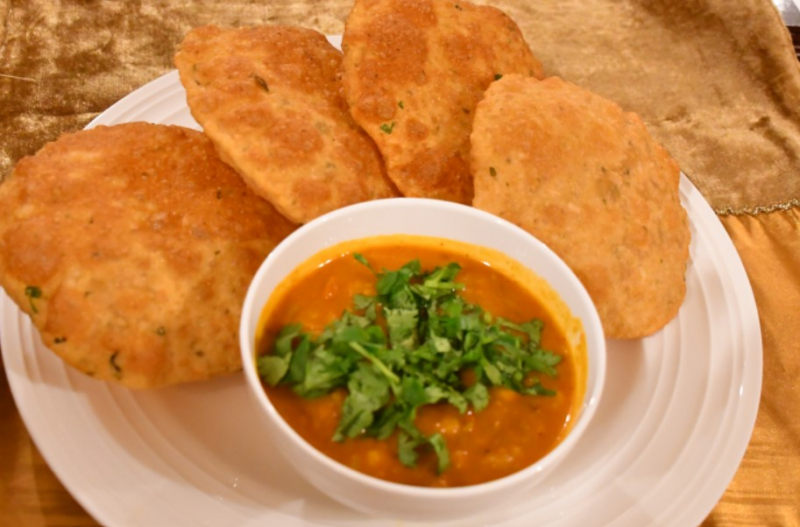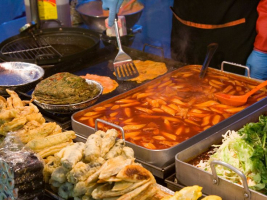Top 10 Best Street Food in Delhi
Bali is a tourist destination with a lot of delicious food. Toplist has compiled the information and listed the 10 best street food in Delhi. Let's find out ... read more...with Toplist!
-
Chole Bhature is a popular North Indian dish that consists of spicy chickpea curry (chole) served with deep-fried bread (bhature). It is a beloved street food and a popular choice for breakfast or lunch in Delhi and other parts of India.
The chole (chickpea curry) is the star of this dish. It is made from cooked chickpeas simmered in a flavorful and spiced tomato-based gravy. The gravy is typically seasoned with a blend of aromatic spices such as cumin, coriander, garam masala, turmeric, and chili powder. The combination of spices gives the chole a rich and tangy flavor. It is common to find whole spices like cloves, cinnamon, and bay leaves in the curry, which adds an extra layer of aroma.
Bhature is a deep-fried bread made from a dough of all-purpose flour (maida), yogurt, oil, and a pinch of salt. The dough is kneaded until soft and pliable, then rolled out into small, round shapes. The rolled dough is deep-fried until it puffs up and turns golden brown. The result is a fluffy, crispy bread that complements the spicy chole.
Chole Bhature is typically served hot. The chole is ladled onto a plate, and the hot, puffed bhature is served alongside. The dish is often garnished with chopped onions, cilantro, and a squeeze of fresh lemon juice. Some places also serve pickles or a side of yogurt (raita) to balance the spiciness of the curry.
Chole Bhature is a hearty and satisfying dish that offers a combination of flavors and textures. The soft and flavorful chickpea curry pairs perfectly with the crispy and fluffy bread. It is a popular street food that is enjoyed by people of all ages, and it has become an iconic part of North Indian cuisine.

Screenshot via https://mothershandrecipe.blogspot.com/2018/06/punjabi-spicy-and-tasty-cole-bhature.html 
Screenshot via https://mothershandrecipe.blogspot.com/2018/06/punjabi-spicy-and-tasty-cole-bhature.html -
Golgappe, also known as Pani Puri, is a popular street food snack in India, including Delhi. It is a beloved and flavorful dish that consists of small, crispy, hollow puris filled with a mixture of flavored water (pani), tamarind chutney, mashed potatoes, and spices.
Golgappe begins with small, deep-fried, round puris made from a dough of semolina or wheat flour. These puris are crispy and hollow, creating a perfect vessel for the flavorful fillings and spicy water.
The highlight of Golgappe is the tangy and spiced water, known as pani. The pani is made by combining various ingredients such as tamarind pulp, mint leaves, coriander leaves, green chili, chaat masala, black salt, and roasted cumin powder. The result is a refreshing and flavorful water that adds a burst of tanginess and spice to each bite.
The puris are typically filled with a mixture of mashed potatoes, chickpeas, and spices. The mashed potatoes add a creamy and hearty element to the dish, while the chickpeas provide a nutty and protein-rich component. Additional fillings can include finely chopped onions, sev (crispy fried noodles), and boondi (small fried chickpea flour balls).
To enjoy Golgappe, you take a puri and carefully create a small hole in it. The puri is then filled with the potato-chickpea mixture and topped with some tamarind chutney. It is dipped into the pani, ensuring the puri is well-coated with the tangy water. The filled puri is then immediately eaten in one bite, creating an explosion of flavors and textures in the mouth.
Golgappe is loved for its sweet, tangy, spicy, and crunchy elements. It is a popular street food snack that is enjoyed by people of all ages. In Delhi, you can find Golgappe being sold at street food stalls and chaat vendors in bustling markets and busy street corners.

Screenshot via https://timesofindia.indiatimes.com/life-style/food-news/the-tangy-story-of-golgappa-indias-favorite-street-food/photostory/75831223.cms 
Screenshot via https://www.chefkunalkapur.com/recipe/pani-puri/ -
Poori Aloo is a popular and delicious North Indian dish consisting of deep-fried bread called poori served with a flavorful potato curry. It is a classic combination that is enjoyed for breakfast, lunch, or even as a special festive meal.
Poori is a deep-fried bread made from whole wheat flour, salt, and water. The dough is kneaded until smooth and then rolled out into small rounds. These rounds are deep-fried until they puff up and turn golden brown. Pooris are known for their light and fluffy texture, crispy exterior, and delicious aroma.
The accompanying potato curry, known as Aloo Curry or Aloo Sabzi, is made from boiled potatoes cooked in a spiced tomato-based gravy. The potatoes are usually cubed or mashed and cooked with a blend of aromatic spices such as cumin, coriander, turmeric, red chili powder, and garam masala. The gravy may also include onions, ginger, garlic, and other flavor-enhancing ingredients. Aloo Curry is typically mildly spiced and has a rich, comforting flavor.
To enjoy Poori Aloo, the hot and freshly fried pooris are served with the flavorful aloo curry. The pooris are usually served flat on a plate or in a basket, while the aloo curry is ladled generously over them. The dish is often garnished with fresh cilantro leaves and served with pickles, yogurt (raita), or chutney on the side. The combination of the crispy pooris and the savory potato curry creates a delightful and satisfying meal.
Poori Aloo is a popular dish across North India and is loved for its taste, simplicity, and versatility. It is commonly served during special occasions, festivals, or as a weekend brunch treat. The dish provides a delightful play of textures and flavors, making it a favorite among both adults and children.

Screenshot via https://www.pinterest.com/pin/749004981759658442/ 
Screenshot via https://muditaskitchen.com/bedmi-poori-with-aloo-potato-sabji/ -
Dahi Bhalle, also known as Dahi Vada, is a popular Indian street food and snack that consists of deep-fried lentil dumplings served with yogurt, chutneys, and spices. It is a refreshing and flavorful dish that is enjoyed across various regions in India, including Delhi.
Dahi Bhalle begins with making the bhalle, which are soft and spongy lentil dumplings. The most common lentils used for making bhalle are urad dal (split black gram) or moong dal (split green gram). The lentils are soaked, ground into a smooth batter, and then whipped to incorporate air, resulting in a light and fluffy texture. The batter is seasoned with spices such as salt, cumin, and asafoetida. Small portions of the batter are deep-fried until they become golden brown and cooked through.
After frying, the bhalle are soaked in water for a while to remove excess oil and to make them moist. Then, they are transferred to a serving dish and covered with thick, beaten yogurt. The yogurt used is often seasoned with salt, sugar, roasted cumin powder, and sometimes a pinch of black salt to enhance the flavor.
Dahi Bhalle are typically garnished with various chutneys and toppings to add tanginess, sweetness, and crunch. The two commonly used chutneys are tamarind chutney (made from tamarind pulp, jaggery, and spices) and green chutney (made from mint, coriander, green chili, and lime). These chutneys are drizzled over the yogurt-covered bhalle. Additionally, finely chopped onions, sev (crispy fried noodles), and chopped coriander leaves are sprinkled on top for added texture and freshness.

Screenshot via https://www.cookingdivamanjusha.com/2016/03/dahi-vada-dahi-bhalla-recipeholi-recipe.html 
Screenshot via https://cookingwithmeena.blogspot.com/2014/09/dahi-balle.html -
Rolls, also known as Kathi Rolls or Frankie Rolls, are a popular street food in India. They are a type of wrap or roll that consists of a flatbread (roti or paratha) filled with various fillings, such as marinated and grilled meats, vegetables, sauces, and chutneys. Rolls offer a convenient and flavorful way to enjoy a quick meal or snack on the go.
The base of a roll is typically a flatbread, which can be either a soft roti or a flaky paratha. Roti is made from whole wheat flour and cooked on a griddle, while paratha is a layered and flaky bread made from whole wheat flour and ghee (clarified butter). The flatbread is cooked until it is soft, pliable, and slightly crispy.
To prepare a roll, the flatbread is typically heated on a griddle or tawa and then layered with the desired fillings. The fillings are spread across the center of the bread, and additional chutneys and sauces are drizzled on top. The roll is then tightly wrapped, securing the fillings within the flatbread.
Rolls are often served with a side of fresh salad, pickles, or yogurt (raita) to complement the flavors and add a cooling element. They are usually served hot and can be enjoyed as a quick snack or a complete meal depending on the size and filling.
Rolls are incredibly versatile, and you can find a range of variations across different regions of India. They are a popular street food and can be found at food stalls, fast-food joints, and even some restaurants. Rolls are loved for their convenience, portability, and the explosion of flavors they offer.

Screenshot via https://spoonuniversity.com/place/14-joints-that-serve-the-best-kathi-rolls-in-delhi 
Screenshot via https://spoonuniversity.com/place/14-joints-that-serve-the-best-kathi-rolls-in-delhi -
Kachori with Sabzi is a popular North Indian dish that consists of deep-fried flaky pastries (kachoris) served with a flavorful vegetable curry (sabzi). It is a delicious and satisfying combination that is often enjoyed as a breakfast or snack option.
Kachoris are deep-fried pastries made from a dough of refined flour (maida) or whole wheat flour (atta) combined with ghee or oil. The dough is rolled out into small circles, and a filling is placed in the center. The filling can vary, but it typically includes a mixture of spiced lentils (such as moong dal or urad dal), spices, and herbs. The filled dough is then sealed and deep-fried until it becomes golden brown and crispy. The result is a flaky and flavorful pastry with a slightly crunchy exterior.
The accompanying sabzi is a vegetable curry or gravy that is served with the kachoris. The sabzi can be made with a variety of vegetables, such as potatoes, peas, carrots, cauliflower, or a combination of these. The vegetables are cooked with a blend of aromatic spices, including cumin, coriander, turmeric, and garam masala. Some variations may also include tomatoes, onions, ginger, and garlic for added flavor. The sabzi is typically mildly spiced and has a thick and rich texture.
To enjoy Kachori with Sabzi, the deep-fried kachoris are served alongside the vegetable curry. The kachoris are often broken into smaller pieces or slightly crushed, and the sabzi is spooned over them. The combination of the crispy and flaky kachoris with the flavorful and comforting sabzi creates a delightful contrast of textures and tastes. It is common to garnish the dish with chopped coriander leaves and serve it with pickles, yogurt (raita), or chutneys on the side for added tanginess and freshness.

Screenshto via https://www.sailusfood.com/aloo-ki-sabzi-kachori-aloo-recipes/kachori-aloo-sabzi/ 
Screenshot via https://www.archanaskitchen.com/baked-kachori-aloo-recipe-kolkata-style-club-kachori -
Samose with Chole is a popular and delicious combination of two classic North Indian dishes. It consists of crispy, deep-fried triangular pastries called samosas served with a spicy and tangy chickpea curry known as chole. This combination is often enjoyed as a snack, appetizer, or even as a meal.
Samosas are a popular Indian snack that is loved for its crispy exterior and flavorful filling. The outer covering of samosas is made from a mixture of all-purpose flour (maida), oil or ghee, and water, which is kneaded into a firm dough. The dough is then rolled out into thin circles, cut into halves, and folded into triangular shapes. The samosa filling typically consists of a mixture of spiced potatoes, peas, onions, and various aromatic spices such as cumin, coriander, and garam masala. The filled samosas are deep-fried until they turn golden brown and become crispy.
Chole, also known as Chana Masala, is a popular North Indian curry made from chickpeas (chana) cooked in a flavorful gravy. The chickpeas are soaked overnight and cooked until tender. The gravy is prepared using a blend of spices such as cumin, coriander, turmeric, and a special chole masala spice mix that gives it its distinct flavor. The curry is often tangy and can include ingredients like onions, tomatoes, ginger, garlic, and green chilies. Chole is known for its rich, spicy, and aromatic taste.
To enjoy Samose with Chole, the hot and crispy samosas are served with a generous amount of chole curry. The samosas are typically accompanied by a side of tangy tamarind chutney and spicy green chutney for dipping. Some people also like to add a dollop of yogurt (raita) or sprinkle chopped onions, cilantro, and chaat masala on top for added flavor and freshness.

Screenshot via https://www.swiggy.com/restaurants/tilak-munjal-r-panchkuian-road-wale-famous-samose-chole-lala-jagat-narayan-marg-pitampura-delhi-12262 
Screenshot via https://pakistanichefs.com/delicious-punjabi-samosa-and-chole-pakistani-food-recipe/ -
A frozen dairy treat from the Indian subcontinent is called kulfi. "Traditional Indian ice cream" is how it is frequently described. The Mughal era of Delhi in the sixteenth century gave rise to kulfi. It can be found in the national dishes of Trinidad & Tobago, India, and Pakistan. It is also well-liked in the Middle East, Bangladesh, Myanmar, Nepal, and Sri Lanka.
Compared to ordinary ice cream, kulfi is creamier and denser. It has a variety of flavors. Cream, rose, mango, cardamom, saffron, and pistachio are traditional ones. Avocado, strawberry, peanut, orange, apple, and peanut are examples of more recent flavors. Since kulfi isn't whipped like ice cream is, it's a rich, solid treat that tastes like frozen custard. As a result, it's occasionally seen as a different kind of frozen dairy dish. Kulfi melts more slowly than ice cream due of its density.
Qulfi, which means "covered cup" in Persian, is where the word kulfi originates. During the Mughal Empire in the sixteenth century, Delhi was the birthplace of the dessert. In the Indian subcontinent, the combination of rich evaporated milk was already widely used in desserts. Kulfi was created in the Mughal era when this mixture was flavored with saffron and pistachios, placed within metal cones, and submerged in slurry ice. The Mughal emperor Akbar's thorough administrative history, Ain-i-Akbari, describes both the transit of Himalayan ice to warmer climates and the use of saltpeter for refrigeration.

Screenshot via https://www.blog.sagmart.com/take-delightful-relish-sweet-kulfi-end-summer-season/ 
Screenshot via https://www.blog.sagmart.com/take-delightful-relish-sweet-kulfi-end-summer-season/ -
Chicken tikka is a popular dish in Indian and Pakistani cuisine. It consists of small, boneless pieces of chicken that are marinated in a flavorful mixture of spices and yogurt, then traditionally cooked in a tandoor (clay oven). The marinade infuses the chicken with aromatic flavors and helps tenderize the meat.
The chicken pieces are typically marinated in a mixture of yogurt, spices, and other flavorings. Common spices used in the marinade include cumin, coriander, turmeric, paprika, ginger, garlic, and garam masala. The yogurt helps to tenderize the chicken and adds a tangy flavor to the dish.
Traditionally, chicken tikka is cooked on skewers in a tandoor, which is a hot clay oven. The skewered chicken is placed in the tandoor and cooked at high temperatures, resulting in a smoky and charred flavor. However, if you don't have a tandoor, you can also cook chicken tikka on a grill, in the oven, or on a stovetop grill pan.
Chicken tikka is often served as an appetizer or as part of a larger meal. The cooked chicken pieces are typically removed from the skewers and arranged on a platter. They can be garnished with fresh coriander leaves and served with mint chutney, tamarind chutney, or a squeeze of lemon juice. Chicken tikka can also be used as a filling in wraps or added to salads.
Chicken tikka can be prepared in different ways to suit personal preferences. For example, some recipes call for using bone-in chicken, while others use boneless chicken. Additionally, regional variations may incorporate different spice blends or additional ingredients like yogurt, cream, or tomato paste to achieve unique flavors.

Screenshot via https://scrumpdillyicious.blogspot.com/2010/10/grilled-chicken-tikka-paneer-tikka.html 
Screenshot via https://scrumpdillyicious.blogspot.com/2010/10/grilled-chicken-tikka-paneer-tikka.html -
Parathas are a type of Indian flatbread that is enjoyed as a staple food in many parts of India, Pakistan, and neighboring countries. They are unleavened bread made from whole wheat flour, oil or ghee (clarified butter), and water. Parathas are known for their flaky, layered texture and can be enjoyed plain or stuffed with various fillings.
Paratha dough is made by combining whole wheat flour, a small amount of oil or ghee, and water. The ingredients are kneaded together to form a smooth and pliable dough. The dough is then rested for some time to allow the gluten to relax, making it easier to roll out the parathas.
After the dough has rested, it is divided into smaller portions. Each portion is rolled out into a thin circle using a rolling pin. To create the flaky layers, the rolled-out dough is brushed with melted ghee or oil and folded into pleats or a square. This process is repeated a few times to create multiple layers within the paratha.
Once the paratha is rolled and layered, it is cooked on a hot griddle or tawa. The paratha is placed on the heated surface, and both sides are cooked until golden brown. Ghee or oil is typically brushed on the surface of the paratha during the cooking process to enhance its flavor and ensure even browning.
Parathas can be enjoyed plain or stuffed with various fillings. Some popular stuffed parathas include aloo paratha (potato stuffing), paneer paratha (cottage cheese stuffing), and gobhi paratha (cauliflower stuffing). The filling is placed in the center of the rolled-out dough, and the edges are sealed before rolling it out again and cooking it on the griddle.
Parathas are a versatile bread that can be enjoyed with a variety of accompaniments. They are often served with yogurt, pickles, chutneys, or curries. Parathas can be eaten for breakfast, lunch, or dinner and are loved for their delicious taste and ability to be customized with different fillings.

Screenshot via https://www.thespruceeats.com/how-to-make-parathas-pan-fried-indian-flatbread-4122134 
Screenshot via https://www.thespruceeats.com/lachcha-paratha-layered-indian-bread-1957343































